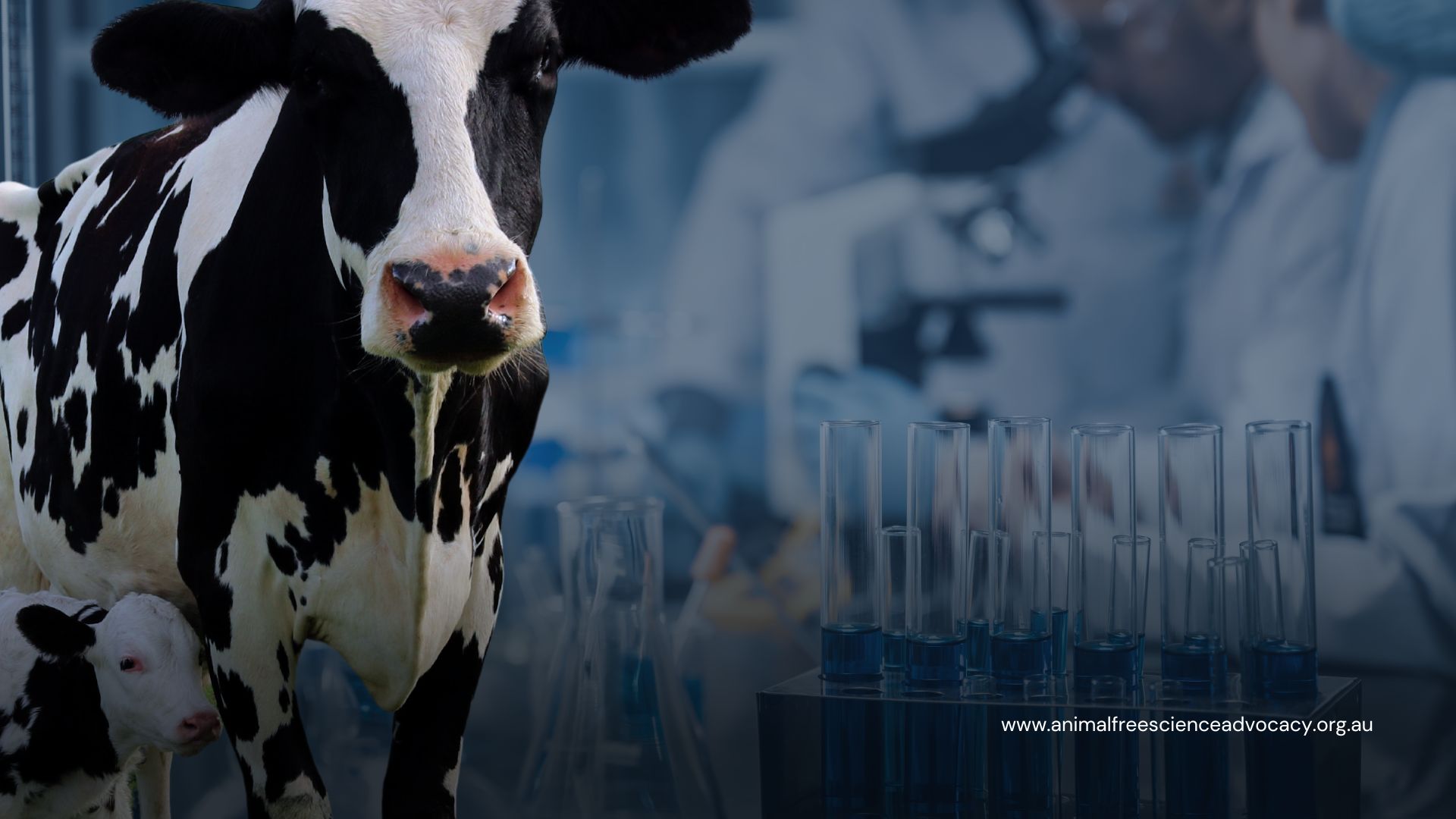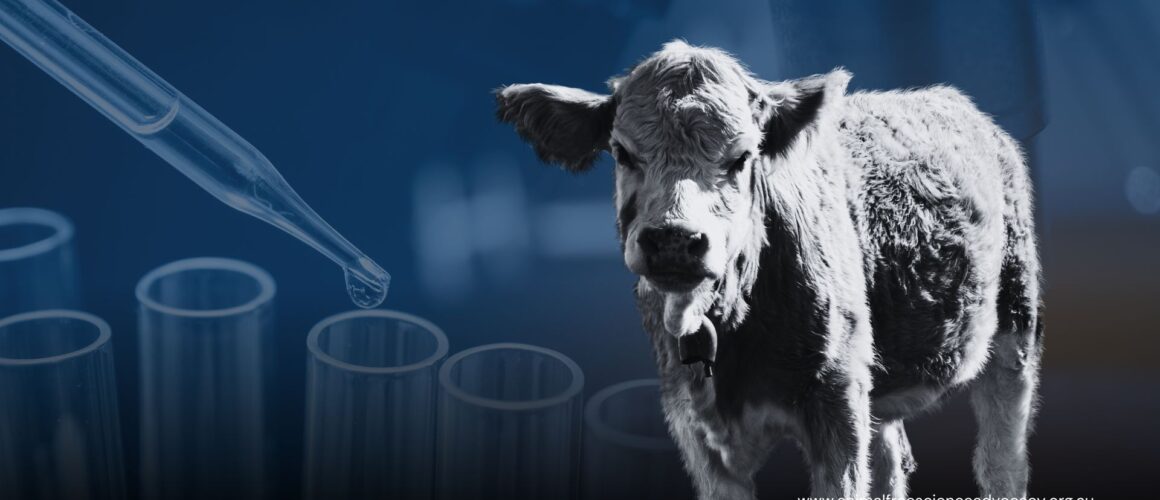Discover ethical and scientifically-valid animal-free approaches to research in this article. Animal-Free Science Advocacy highlight the cruel practice of using fetal calf serum and also why the focus should be shifted towards human cell and tissue cultures instead.
Background
Animal-Free Science Advocacy considers the use of human cell and tissue culture to be, clearly, a more ethical and scientifically-valid mode of research than using animals. Unfortunately though, even when using these “in-vitro” methods, a component of animal cruelty can possibly still remain.
Human cells and tissue are grown in a culture form and in order for the cells or tissue to grow and proliferate, a source of nutrients, namely hormones and growth factors must be added. The usual supplement is fetal calf serum – also known as fetal bovine serum – a product that is cruelly derived from the fetuses of cows found pregnant at slaughter. Serum is blood without any cells, platelets or clotting factors and fetal calf serum especially, is considered to be a rich source of nutrients.

It has been estimated that around half a million litres of raw FCS is produced each year worldwide which equates to the harvesting of more than one million bovine fetuses annually. (1) Some sources have suggested that the actual figure may be closer to two million fetuses per year. (2)
Method of collection:
After slaughter and bleeding of the cow at an abattoir, the mother’s uterus containing the calf fetus is removed during the evisceration process (removal of the mother’s internal organs) and transferred to the blood collection room. (3). A needle is then inserted between the fetus’s ribs directly into its heart and the blood is vacuumed into a sterile collection bag. This process is aimed at minimizing the risk of contamination of the serum with micro-organisms from the fetus and its environment. Only fetuses over the age of three months are used otherwise the heart is considered too small to puncture. (4)
Once collected, the blood is allowed to clot at room temperature and the serum separated through a process known as refrigerated centrifugation.
It remains questionable as to whether or not fetuses have already died from anoxia (deprivation of oxygen) prior to serum collection. Nevertheless, no anaesthesia is given, despite their possible ability to experience pain and discomfort.
Disadvantages of using FCS:
- Serum is a major source of viral contaminants which once present, are almost impossible to remove from cultures. It can contain viruses, prions (a protein that can transform into a rogue agent) and mycoplasma (considered to be a primitive form of bacteria), (5) each of which can skew the outcome of scientific experiments.
- Many substances present in FCS have not yet been identified, and of the substances which have been, the function of the cultured cells is not always clear.” (6)
- FCS can interfere with genotypic and phenotypic cell stability, which can also influence experimental outcome.
- Serum can suppress cell spreading, attachment and embryonal tissue differentiation, which is the process by which embryonic cells develop into specialized cells for particular functions. Critically, this can actually prevent an objective of cell growth research especially when we talk about growing new organs and limbs.
Alternatives:
Rather than just criticising a process of research that uses animals, our objective at AFSA is always to present realistic and viable scientific alternatives. In this case, like all, a number of alternatives to the usage of FCS do actually exist!
- The sefrec database gives an overview of 500 cell culture media and 32 cell lines that are currently available for serum-free culture systems. The database, established with the support of the 3R’s Research Foundation, is interactive and access is free-of-charge.
- Animal Free Research UK and the 3Rs-Centre Utrecht Life Sciences launched the Fetal Calf Serum (FCS)-free database. The database will allow researchers to identify serum-free media for specific cell types and to exchange information on the quality of FCS-free media, contributing to replacement of animals used for research and the reproducibility of in vitro methods.
- GoodCellkulture aims to provide informations on the nutrient medium fetal calf serum, and why the researcher should replace the product with a chemichally defined nutrient medium.
What can you do?
- If you are directly involved in research and require sera, consider the use of an alternative to FCS.
- If you are a member of an animal ethics committee insist that an alternative to FCS is used.
- Contact the Animal Ethics Office of your university/institution and urge them to ban the use of FCS.
The Australian code for the care and use of animals for scientific purposes (8th edition 2013) states that “Methods that replace or partially replace the use of animals must be investigated, considered and. where applicable, implemented.” (7)
In summary, AFSA believes strongly that researchers have a moral and a legal obligation to replace animals with alternatives when they are available. We feel it therefore makes sense to shift toward a more humane and scientifically valid methodology.
To find out more about animal-derivative free medical products, listen to AFSA’s podcast episode with Nisha Narang, the CEO and founder of Leorah Clinical.
References
- Carlo E A Jochems, Jan B.F. van der Valk, Frans R Stafleu and Vera Baumans. 2002. “The use of fetal bovine serum: ethical or scientific problem?” Alternatives to Laboratory Animals (ATLA) 30, 219-227.
- “Serum-free media for cell culture” compiled by Focus on Alternatives, August 2005.
- Personal correspondence with AQIS Meat Operations.
- Carlo E A Jochems, Jan B.F. van der Valk, Frans R Stafleu and Vera Baumans. 2002. “The use of fetal bovine serum: ethical or scientific problem?” Alternatives to Laboratory Animals (ATLA) 30, 219-227.
- E. Falkner, H. Appl, C. Eder, K. Macfelda, U. Losert, H. Schoeffl, W. Pfaller,. “Serum Free Cell Culture Media Updated Product Guide 1/2004-05,” Zet, Centre for Alternative and Complementary Methods to Animal Testing, Austria .
- Carlo E A Jochems, Jan B.F. van der Valk, Frans R Stafleu and Vera Baumans. 2002. “The use of fetal bovine serum: ethical or scientific problem?” Alternatives to Laboratory Animals (ATLA) 30, 219-227.
- The Australian code for the care and use of animals for scientific purposes (8th edition 2013). Page 1
